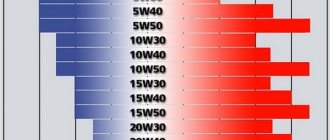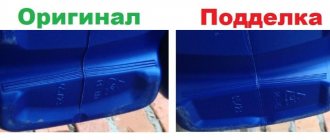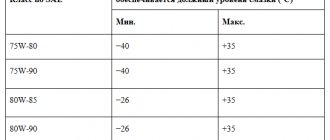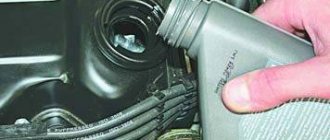Content
- SAE classification
- API GL-1 classification
- GL-2
- GL-3
- GL-4
- GL-5
- New API classes
Transmission oils are used to lubricate heavily loaded vehicle components to ensure their stable operation for a long time. They are replaced every 60-150 thousand kilometers or after 3-7 years if the vehicle is used infrequently. In order for transmission oil to fully perform its functions, it must correspond to the operating characteristics of the vehicle and the design of the gearbox (gearbox). To select the optimal lubricant, you need to know which product category it belongs to according to existing standards.
Features of the oil
The characteristics of a lubricating fluid depend not only on the viscosity class, but also on its composition. Regarding the latter, it is worth noting that the most popular and high-quality option is synthetic gear oil. It is capable of providing the highest possible protection against wear of manual transmission parts and drive axle, creating an oil film on their surfaces, filling irregularities and enveloping undamaged areas.
Another purpose of this lubricant is to improve the quality of the gearbox. This concerns primarily smoothness.
Thanks to its viscosity, it is easily and evenly distributed over the parts, compensating for friction and replacing it with sliding. Due to this, the manual transmission operates silently and efficiently.
In addition, this makes it possible to increase the heat exchange between the oil and the components being processed: the latter, when overheated, give up part of their energy to the colder liquid.
As for semi-synthetic mixtures, they are not recommended for frequent use. The fact is that mineral components can contribute to transmission jamming. Moreover, liquids of this type have less resistance to frost, while synthetics respond well to both the cold itself and sudden changes.
SAE classification
It was developed by the American Society of Mechanical Engineers (ASME). The division into groups was based on the viscosity coefficient. It determines the temperature range at which the lubricating fluid retains its operating properties. Like motor oils, transmission oils are divided into two large groups: winter and summer. Products of the first category have the index W (Winter - “winter”), but it is not included in the labeling of the second category. In all-season lubricants, both designations are indicated. For example, SAE 70W, SAE 140, SAE 75W-85.
Popular lubricant
One of the most popular transmission lubricants is 75W90 multigrade oil. It is used by most motorists because it has a high level of protection for parts, an increased temperature range, and unique fluidity properties. Changing lubricants for manual transmissions and drive axles occurs much less frequently than in the case of a motor, the more important it is to choose a good, durable option.
Classification by API
Developed by the American Petroleum Institute. The basis for the division into classes is the operating conditions of the transmission and its design: mechanical (manual transmission) or automatic (automatic transmission). The type of additives and their percentage in the base are taken into account as additional factors. The API system includes the following categories of gear oils.
GL-1
. This is the cheapest class of lubricants, designed for transmission operation under simple conditions without special loads. The composition, as a rule, includes only the base - oils without additives. Some manufacturers may add corrosion inhibitors, anti-foam additives, etc. in small quantities. Recommended for non-synchronized manual transmissions of agricultural machinery and trucks.
GL-2
. Standard products designed for worm gears operating in moderate conditions. It differs from GL-1 oils in having better anti-friction and anti-wear characteristics. Used for the same vehicles.
GL-3
. The main area of application is the checkpoint of freight transport. Oils differ from previous categories by a higher percentage of wear additives - up to 2.7%. The product is intended for moderate operating conditions and cannot be used for hypoid gears.
GL-4
. A universal lubricant for gearboxes of any vehicle operating in a wide variety of conditions. The base contains 4% extreme pressure additives, so the use of such a lubricant can significantly extend the service life of the gearbox. GL-4 transmission oils are the most popular; they are well suited for both synchronized and non-synchronized gearboxes with small displacement bevel and hypoid gears.
GL-5
. This category of gear oils is selected in cases where vehicles have to operate in very difficult conditions under significant loads. The lubricant contains up to 6.5% additives for various purposes. GL-5 products have been specifically developed for highly offset hypoid gears, but can also be used as a multi-purpose lubricant for manual transmission components other than the gearbox. In the latter case, confirmation from the vehicle manufacturer is required.
New API classes
. This includes PG-1 (MT-1) and PG-2. Transmission oils of these classes are intended for highly loaded transmissions of freight and passenger vehicles carrying large loads. For example, buses. The basic composition is similar to GL-5 oils, but has a slightly different set of additives. Thanks to this, PG-1 and PG-2 have better thermal stability and higher compatibility with seal materials.
Oil tests
On the consumables market you can find a large number of different oils.
Of course, you don’t want to randomly take and try one or another option, because if you make a mistake, you’ll have to be left without a vehicle for a long time, and also incur serious financial costs.
Therefore, the best solution is to look at the results of independent testing by automotive experts. There are quite a few such studies, but in general they give approximately the same results: only the test samples change.
The main task, as a rule, is to study viscosity at extremely low temperatures, because -40 degrees is only an approximate average value. Meanwhile, not only the operation of the transmission, but also fuel consumption depends on this indicator. There are oils in different price categories. As a rule, the cost ranges from 400 to 1300 rubles per liter.
The samples under study are placed under low temperature conditions. The most accurate test of 75W90 gear oils will be carried out in natural frosts (Siberian and northern regions), it will provide accurate information about the behavior of the fluid in practice. As a rule, the thermometer drops to 45–50 degrees below zero, as this allows you to find out the minimum threshold for the lubricant to solidify.
Classification according to GOST
The main standard is GOST 17479.2-85. It classifies transmission oils according to two indicators:
- kinematic viscosity. GOST provides for four classes - 9, 12, 18, 34;
- operational quality. Oils are divided into five groups - TM1-TM5, each of which corresponds to the same GL class.
When designating a domestic product, both indicators are indicated. For example, TM-5-18.
Requirements
There are several important requirements that apply to transmission fluid. Compliance with them directly affects the increase in the service life of individual elements and the entire unit as a whole:
- chemical stability and low tendency to foam;
- gentle effect on seals made of rubber;
- viscosity suitable for Russian conditions.
Takayama 75W-90 gear oil meets all these requirements.
How to decipher SINTEC product markings
The Sintec Lubricants product range includes a large selection of gear oils for various purposes. To choose the optimal lubricant for your car, it is enough to correctly decipher the product labeling. For example, if we read: gear oil SINTEC TM4-12 (GL-4) SAE 80W-85, then this means the following:
- the lubricant contains a large amount of extreme pressure additives (TM-4) and has a kinematic viscosity class of 12;
- can operate in light, standard and severe operating conditions, including synchronized gearboxes (GL-4);
- The lubricant is all-season, designed for a minimum temperature of –26 °C (SAE 80W-85).
Please note that our catalog also presents unique developments from SINTEC - transmission oils TSP-15K (for heavily loaded transmissions of heavy-duty vehicles and buses) and ATF DEXTRON (for torque converters, power steering, etc.).
MIL specification
Sometimes, along with the API specification, the MIL specification developed by the US military is printed on the packaging container.
- MIL-L-2105 A. The scope, composition and requirements of this class of MIL specification roughly correspond to the API subsection GL-4 transmission fluids.
- MIL-L-2105 B. Frequently used requirements and scope for lubricant classification. The parameters of 75W90 oil of this class correspond to the characteristics of API GL-5.
- MIL-L-2105 C. Specifications for technical fluids applicable at any time of the year with a viscosity of 75W/90; 80W/90; 85W140. This class surpasses its predecessor in standards. Complies with API class GL-4.
The indication of MIL compliance on the lubricant packaging indicates the high quality of the product. Not all transmission oils have this parameter.
Performance characteristics of 75W90 gear oil
According to the API classification, oil performance is divided into 6 types. Each type is marked with an index that serves as an indicator of the scope of use and quality characteristics of the lubricant.
Two types of oils are used for passenger cars: GL4 and GL5 (in the Russian market the designations TM4 and TM5 are used, respectively).
Differences between GL4 and GL5 fluids
Oil of group GL4 for units with medium load. This type is used for manual transmissions, as well as for transmission elements with a spiral bevel gear. In addition, it is possible to operate on hypoid gears at high speeds, but with small or moderate torques. The maximum operating temperature in systems of this category does not exceed 150C. The load on the system reaches 3000 MPa. Front-wheel drive cars fall into this category.
What does the marking 75W90 mean?
For more convenient navigation in the variety of all types of technical fluids, the Society of Automotive Engineers (SAE) created a unified labeling system, the main criterion for which is viscosity.
Substances for engines and transmissions can be seasonal (i.e. used exclusively in summer or only in winter) or universal (i.e. all-season).
Transmission oil decoding
Summer lubricants are marked with a numerical value from 80 to 250. The designation of winter oil contains the letter W (70W, 75W, etc.). Universal ones are indicated by a double indicator (for example, 75W90), where the first number reflects the fluidity of the lubricant at sub-zero temperatures, and the second, respectively, at positive temperatures. These fluidity indicators demonstrate at what extreme ambient temperatures the lubricant operates. For all-season transmission fluid 75W90, the temperature thresholds are -40 and +35C.
Graph of transmission oil viscosity depending on ambient temperature
The choice of this particular temperature range is explained by the operating features of the transmission system.
Preventing friction between system elements and the lubricating characteristics of oils are directly related to each other. However, along with an increase in viscosity, not only the lubricating qualities improve, but the resistance also increases, due to which transmission power is lost, since additional energy consumption is required to push the oil out from under the gear teeth. At the same time, liquids with increased viscosity values thicken in frosty conditions. Less viscous lubricants retain their consistency in cold weather, but do not provide such a strong protective layer, and are inferior in lubricating properties to more viscous ones.
Manufacturers maintain a balance of these two characteristics using special additive sets. In practice, this means that each plant uses its own individual formula. That is why lubricants labeled 75W90 from different manufacturers may differ slightly in characteristics, and, consequently, in cost.
Most often, 75W90 gear oils are classified as synthetic, but some manufacturing companies position this type of fluid as semi-synthetic. However, the only difference between these oils is the proportion of synthetic substances contained (20-40%) and the amount of additives (from 2 to 15%).
Technical characteristics 75w 80
Guided by the SAE division, the oil's mission is based on thickness. Transmission fluid under the brand name sae 75w 80 has found its application in manual transmissions and axles. The alphanumeric designation 75W informs the consumer that it can be used as a winter liquid, this is indicated by the letter W, the number 75, which indicates that this liquid can ensure normal operation of mechanisms at a temperature of - 26C. That is, the smaller the number in front of the letter, the higher the fluidity of the oil at low temperatures. The second number, in our case - 80, shows the maximum temperature above 0. That is, based on the markings, you can understand that this lubricant is intended to work at temperatures from -40C...+30C. But more on that below.
Important. In areas with a temperate climate, it is advisable to use lubricants with a viscosity class of 80; for use in areas with a tropical climate, it makes sense to fill in oils with an index of 140.
In addition to the SAE systematization, all lubricants used for gearboxes can be divided based on API grouping. It is based on a set of assessments of operational parameters. This allows you to divide all oils into six groups. For passenger vehicle transmissions, oils belonging to the GL-4 and GL-5 groups are used; of course, each of them has its own distinctive characteristics. Thus, transmission oil GL-4 is used for mechanical power transmission. This fluid is poured into front-wheel drive cars that move at high speeds, but at the same time, the torque should not exceed certain average parameters.
How to choose gear oil
The quality of a transmission lubricant is determined by the tasks it solves. Such a lubricant should:
- perform the heat removal function in the transmission system with high efficiency;
- reduce energy consumption and increase efficiency;
- prevent jamming, friction, scuffing and other mechanical defects;
- perform sound and noise insulation functions;
In addition to the brand and price tag, when choosing gear oil you also need to take into account the following parameters:
- Viscosity Choose the best option depending on the temperature conditions in summer and winter;
- Freezing and ignition temperatures of lubricating fluid. It is better to choose oil with the widest possible range of temperature limits.
- Critical load index and scuffing index: the higher these parameters, the higher the quality of the transmission fluid;
- The minimum welding load threshold should be 3000 Newton.
- For GL5 fluids, the wear rate must be taken into account (no more than 0.4 mm).
Which is better: synthetic or semi-synthetic?
Synthetic oils for the transmission system are of the best quality due to:
- high viscosity index;
- long-term;
- resistance to oxidative processes;
- low volatility;
- resistance to moisture;
- maintaining properties in frost conditions.
The main disadvantage of synthetic lubricating fluids is their high cost. A compromise option for many car owners is semi-synthetic gear oil, which in terms of quality parameters is slightly inferior to synthetics, which is reflected in a price reduction of 15-30%.











